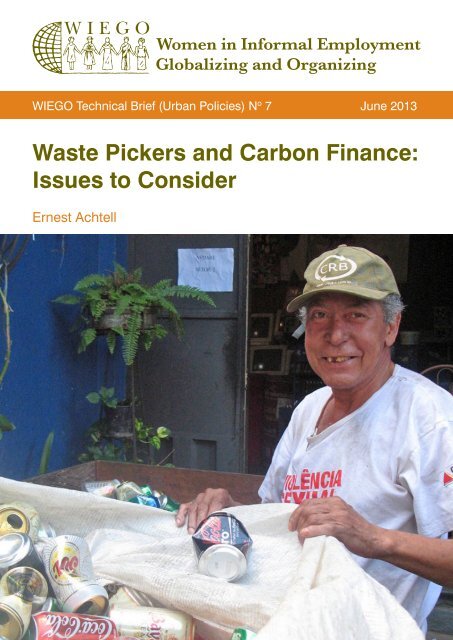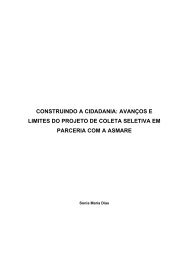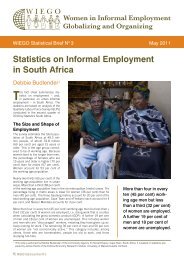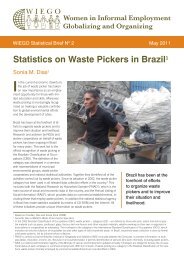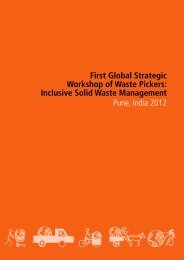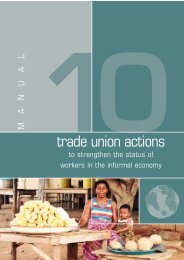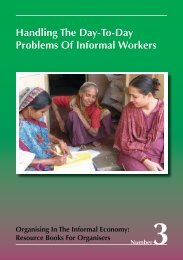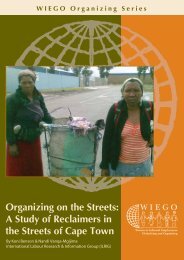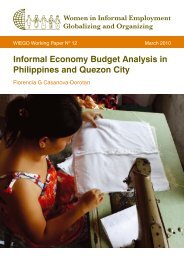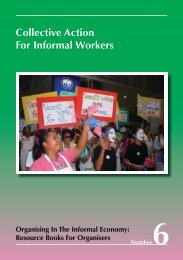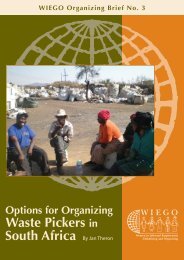Waste Pickers and Carbon Finance: Issues to Consider - WIEGO
Waste Pickers and Carbon Finance: Issues to Consider - WIEGO
Waste Pickers and Carbon Finance: Issues to Consider - WIEGO
- No tags were found...
You also want an ePaper? Increase the reach of your titles
YUMPU automatically turns print PDFs into web optimized ePapers that Google loves.
<strong>WIEGO</strong> Technical BriefsThe global research-policy-action network Women in Informal Employment: Globalizing<strong>and</strong> Organizing (<strong>WIEGO</strong>) Technical Briefs provide guides for both specialized <strong>and</strong> nonspecializedaudiences. These are designed <strong>to</strong> strengthen underst<strong>and</strong>ing <strong>and</strong> analysis ofthe situation of those working in the informal economy as well as of the policy environment<strong>and</strong> policy options.About the AuthorErnest Achtell is a consultant with over 15 years’ experience as a manager <strong>and</strong> technicaladvisor in the international development <strong>and</strong> humanitarian aid sec<strong>to</strong>rs. Ernest hasplayed a central role in strategic planning processes in government <strong>and</strong> non-governmen<strong>to</strong>rganizations <strong>and</strong> successfully designed, managed, <strong>and</strong> evaluated programs in Africa,Asia <strong>and</strong> the UK. Much of Ernest’s recent work has focused on the planning <strong>and</strong> coordinationof innovative responses <strong>to</strong> humanitarian emergencies, as well as government <strong>and</strong>civil society capacity-building in the area of disaster management. With an academicbackground in international environmental policy, Ernest also has a long-st<strong>and</strong>ing interestin issues related <strong>to</strong> waste management in developing countries. Ernest is currentlybased in Nairobi, Kenya.Publication date: June 2013ISBN number: 978-92-95095-65-6Published by Women in Informal Employment: Globalizing <strong>and</strong> Organizing (<strong>WIEGO</strong>)A Charitable Company Limited by Guarantee – Company No. 6273538, Registered CharityNo. 1143510<strong>WIEGO</strong> Secretariat<strong>WIEGO</strong> LimitedHarvard Kennedy School,521 Royal Exchange79 John F. Kennedy Street Manchester, M2 7EN,Cambridge, MA 02138, USA United Kingdomwww.wiego.orgCopyright © <strong>WIEGO</strong>.This report can be replicated for educational <strong>and</strong> organizing purposes as long as thesource is acknowledged.Cover pho<strong>to</strong>graph by: D. Tsou<strong>to</strong>uras
<strong>WIEGO</strong> Technical Brief (Urban Policies) N o 7ContentsExecutive Summary..................................................................................................................................1Introduction.............................................................................................................................................2Methodology.............................................................................................................................................2<strong>Issues</strong> <strong>to</strong> <strong>Consider</strong>....................................................................................................................................3Requirements, Methodology, <strong>and</strong> MBO Capacity....................................................................................3Commercial Viability..............................................................................................................................6Ethical <strong>Consider</strong>ations...........................................................................................................................7Other Funding Options <strong>and</strong> Solutions.....................................................................................................8Recommendations....................................................................................................................................9Conclusion.............................................................................................................................................10References <strong>and</strong> Further Reading............................................................................................................11Websites <strong>and</strong> Other Electronic Resources............................................................................................12Interviewees........................................................................................................................................12Appendix 1: Background Information on <strong>Carbon</strong> <strong>Finance</strong> for <strong>Waste</strong> Picker Organizations.....................13Introduction ........................................................................................................................................131. UNFCCC CDM................................................................................................................................132. Voluntary <strong>Carbon</strong> Markets...............................................................................................................163. <strong>Issues</strong> To <strong>Consider</strong> Regarding <strong>Carbon</strong> Offsets ................................................................................174. Green Climate Fund.......................................................................................................................17
Executive Summary<strong>WIEGO</strong> Technical Brief (Urban Policies) N o 7<strong>Carbon</strong> finance has been cited as a potential source of income for membership-based organizations(MBOs) of informal waste pickers. However, it is important <strong>to</strong> underst<strong>and</strong> issues related <strong>to</strong> carbon offsettrading before proceeding. Some of the main issues arising from this research in<strong>to</strong> the feasibility of MBOspursuing carbon finance include:• The development of carbon offset projects is complex, technical, <strong>and</strong> costly, <strong>and</strong> it would be beyond thecapacity of many waste picker MBOs <strong>to</strong> develop, <strong>and</strong> possibly manage, these types of projects withoutexternal support.• There are technical issues around “additionality” that some waste picker MBOs, due <strong>to</strong> the contexts inwhich they work, may not be able <strong>to</strong> overcome.• The market for carbon credits is weak, which has implications for the commercial viability of new carbonoffset projects.• Important ethical issues surround carbon finance that MBOs may want <strong>to</strong> take in<strong>to</strong> consideration.• Other potential sources of income may be more straightforward for waste picker MBOs <strong>to</strong> pursue, includingpublic <strong>and</strong> private climate funding <strong>and</strong> Corporate Social Responsibility (CSR) arrangements.• MBOs should also be proactive in relation <strong>to</strong> the development of the Green Climate Fund as a potentialfuture source of funding, in pursuing waste management contracts with municipal authorities, <strong>and</strong>investing in innovation.A Word about the Naming DebateThe millions of people worldwide who make a living collecting, sorting, recycling, <strong>and</strong> selling materials thatsomeone else has thrown away are referred <strong>to</strong> by many different terms in different regions. These includescavengers, recyclers, reclaimers, ragpickers, binners, <strong>and</strong> waste pickers. At the First World Conferenceof <strong>Waste</strong> <strong>Pickers</strong>, held in Colombia in 2008, a provisional consensus was reached <strong>to</strong> use the generic term“waste picker” in English (but, in specific contexts, <strong>to</strong> use the term preferred by the local waste pickingcommunity). While an international consensus is still <strong>to</strong> be reached among activists, waste specialists,MBOs <strong>and</strong> non-governmental organizations (NGOs), the term waste pickers has been adopted <strong>and</strong> put in<strong>to</strong>use by <strong>WIEGO</strong> as a useful generic term that suits the purposes of current global networking. In the contextswhere specific terms have been agreed upon <strong>WIEGO</strong> uses the local term.– Sonia Maria Dias, <strong>WIEGO</strong>’s <strong>Waste</strong> Picker Specialist1
<strong>WIEGO</strong> Technical Brief (Urban Policies) N o 7IntroductionMembership-based organizations (MBOs) of informal workers share an interest in building organizationalcapacity <strong>and</strong> sustainability, <strong>and</strong> improving the livelihoods of their members. Some informal waste pickerMBOs in the global South, <strong>and</strong> those that work in partnership with them, have shown an interest in exploringthe feasibility of these MBOs accessing carbon finance, <strong>and</strong> whether this is a realistic <strong>and</strong> appropriatefunding option.The purpose of this research is <strong>to</strong> clarify the requirements for carbon finance mechanisms, <strong>to</strong> provide anassessment of whether informal waste picker MBOs in the global South can reasonably meet these requirements,<strong>and</strong> the potential investments needed <strong>to</strong> successfully secure carbon financing. This documentpresents information related <strong>to</strong> the feasibility of these MBOs accessing carbon finance through the CleanDevelopment Mechanism (CDM) of the United Nations Framework Convention on Climate Change (UN-FCCC), the voluntary carbon market <strong>and</strong> the Green Climate Fund (GCF).While this report presents some ethical issues raised by key informants <strong>and</strong> in the literature, it does notmake judgements about the ethics of carbon finance or carbon offset trading. That is a debate for thoseconsidering carbon finance as an income source <strong>and</strong> beyond the scope of this research. This report alsodoes not make a judgement as <strong>to</strong> whether or not specific, or any, MBOs should pursue involvement in carbonoffset trading, because that is ultimately a decision for their membership. Finally, this report does notreiterate the debate about the merits of recycling over incineration <strong>and</strong> waste-<strong>to</strong>-energy schemes, as thathas been dealt with thoroughly elsewhere <strong>and</strong> many waste picker MBOs <strong>and</strong> their allies oppose the issuingof carbon credits <strong>to</strong> incineration facilities. Rather, this report is an effort at presenting some of the mostsalient issues that should be considered by MBOs <strong>and</strong> their partners when deciding whether <strong>to</strong> pursuecarbon finance.MethodologyThis research was undertaken in two phases. In the first phase, a review of background materials related<strong>to</strong> carbon finance architecture <strong>and</strong> requirements was complemented with key informant interviews. Thefindings from this phase were used <strong>to</strong> prepare interview questions <strong>and</strong> a document entitled “BackgroundInformation on <strong>Carbon</strong> <strong>Finance</strong> for <strong>Waste</strong> <strong>Pickers</strong>.” 1The interview questions <strong>and</strong> “background document” were circulated <strong>to</strong> selected informal solid waste managementstakeholders, with Spanish translations prepared <strong>and</strong> circulated as appropriate. These stakeholderswere then interviewed regarding the information presented in the “background document” on requirementsfor carbon finance <strong>and</strong> in relation <strong>to</strong> the following questions:• What do you think of the requirements?• Do you think that your organization (or your partner organizations) would be interested in getting involvedin carbon emissions trading? If yes, why? If no, why not?• Do you think that your organization has (or your partner organizations have) the capacity <strong>and</strong> resourcesnow <strong>to</strong> develop a carbon offset project?• What type of support would your organization (or your partner organizations) need?• What do you think would be the advantages <strong>and</strong> disadvantages of getting involved in carbon emissionstrading?• What would your organization (or your partner organizations) like <strong>to</strong> do with money earned from sellingcarbon credits?1Please see Appendix 1.2
<strong>WIEGO</strong> Technical Brief (Urban Policies) N o 7The second phase of the assignment comprised the preparation of this report based on the stakeholders’opinions, gathered from the process described above, related <strong>to</strong> the feasibility of waste picker MBOs accessingcarbon finance.The issues <strong>and</strong> discussion points presented in this paper are organized according <strong>to</strong> four inter-relatedthemes that arose during research. Readers should take these themes in<strong>to</strong> consideration when assessingwhether carbon finance is feasible <strong>and</strong> realistic for MBOs of informal waste pickers:• Requirements, methodology <strong>and</strong> MBO capacity• Commercial viability• Ethical considerations• Other funding options <strong>and</strong> solutionsAt different points, ideas are presented regarding the investments that waste picker MBOs may need <strong>to</strong>make in order <strong>to</strong> meet the requirements of developing <strong>and</strong> managing a carbon offset project. A number ofrecommendations for consideration as next steps are also presented.<strong>Issues</strong> <strong>to</strong> <strong>Consider</strong>An observation among key informants is that some waste picker MBOs, in the absence of guidance or information,are interested in entering the carbon market <strong>and</strong> earning income from the sale of carbon credits,in order <strong>to</strong> improve their personal <strong>and</strong> collective circumstances. This opinion often changes once they areinformed about the administrative <strong>and</strong> technical requirements, the costs, the risks, <strong>and</strong> the potential ethicalissues associated with this funding source.Requirements, Methodology, <strong>and</strong> MBO CapacityThe process <strong>and</strong> requirements that waste picker MBOs would need <strong>to</strong> follow in developing a carbonoffset project are detailed in the “background document” prepared in the first phase of this assignment,<strong>and</strong> reproduced in Appendix 1 of this report. As the research behind the preparation of the “backgrounddocument” found, <strong>and</strong> as some stakeholders were already aware, the process of designing a carbon offsetproject <strong>and</strong> preparing a Project Design Document (PDD) under both CDM <strong>and</strong> voluntary markets 2 is highlytechnical <strong>and</strong> complex.MBOs of informal workers, including waste picker organizations, are diverse, at different stages of development,<strong>and</strong> have different abilities <strong>and</strong> capacity-building needs. Some are complex organizations withlarge memberships <strong>and</strong> multiple enterprises that can include banking facilities, online shopping, insuranceschemes, retail shops, <strong>and</strong>/or the implementation of projects with funding from multiple donors, all requiringsophisticated management <strong>and</strong> accounting systems. Some also successfully negotiate <strong>and</strong> managecontracts with municipal authorities <strong>to</strong> provide waste management services. Others are characterized by alack of skills in leadership <strong>and</strong> basic management <strong>and</strong> administration, with a wide array of ongoing training,development, <strong>and</strong> infrastructure needs (Achtell 2012).Despite the sophistication of some MBOs, it would appear that none of those with which the intervieweesare associated could tackle the requirements for developing a carbon offset project <strong>and</strong> preparing a PDD,using in-house expertise only. Interviewees were consistent on this point. For example, one noted that itwas “not realistic” that informal waste picker MBOs could follow the requirements, which another describedas “extremely onerous.”2While some interviewees suggested that the development of a small-scale project under voluntary market guidelines may mean lower transaction costs<strong>and</strong> less bureaucracy than the CDM, one expert has noted that, “voluntary markets offer no short cuts for the informal sec<strong>to</strong>r” (Chintan 2009: 24).3
<strong>WIEGO</strong> Technical Brief (Urban Policies) N o 7As the research found, carbon offset projects are usually developed by large companies with significantcorporate technical, legal <strong>and</strong> project-management capacity, or the resources <strong>to</strong> hire expert consultants,<strong>and</strong> <strong>to</strong> absorb the associated risks. <strong>Waste</strong> picker MBOs would have <strong>to</strong> contract consulting firms <strong>to</strong> develop<strong>and</strong>, potentially, <strong>to</strong> manage their carbon offset projects. Leaving aside ongoing management <strong>and</strong> moni<strong>to</strong>ringcosts, some interviewees noted that the cost of hiring a specialized company <strong>to</strong> develop a PDD could be US$50,000, <strong>and</strong> developing a PDD <strong>and</strong> taking a project through the registration process could cost from US$100,000 <strong>to</strong> US $250,000, or more, with a project development time frame of one <strong>to</strong> two, or more, years. 3According <strong>to</strong> one respondent, waste picker MBOs in Brazil could probably engage with the requirements<strong>and</strong> would possibly have government support in the form of resources <strong>to</strong> hire technical experts. Otherwise,it would appear that none of the MBOs with which the interviewees are associated could make financialcommitments on this scale using solely their own resources. Therefore, for most it would be necessary <strong>to</strong>first invest in developing proposals or business plans demonstrating the financial viability of the project. Itwould also be necessary <strong>to</strong> invest in research <strong>and</strong> building relations with financial backers <strong>to</strong> whom theseproposals or business plans could be presented. These might include donor agencies, venture capitalists,banks or “carbon aggrega<strong>to</strong>rs” that would cover project development <strong>and</strong> registration costs, possibly agree<strong>to</strong> purchase the carbon credits at a fixed price, <strong>and</strong> identify an eventual buyer.Besides waste picker MBO capacity <strong>and</strong> feasibility issues related <strong>to</strong> project development, there are also capacityissues related <strong>to</strong> the methodology. As indicated in the “background document,” a key aspect related<strong>to</strong> carbon offset projects is the use of approved methodology in design <strong>and</strong> moni<strong>to</strong>ring. The most relevantexisting methodology is probably “AMS-III.AJ. Recovery <strong>and</strong> recycling of materials from solid wastes.” Asnoted by a key informant involved in the early stages of methodology development, the initial objective was<strong>to</strong> create another income stream that could be derived from municipal solid waste, in addition <strong>to</strong> previouslyapproved methodologies related <strong>to</strong> the capture of l<strong>and</strong>fill gas (LFG) <strong>and</strong> “methane avoidance projects suchas aerobic composting <strong>and</strong> incineration,” 4 (Peterson <strong>and</strong> Godin 2009: 2) <strong>and</strong> not necessarily or primarily <strong>to</strong>meet the needs of informal waste pickers.The initial idea was that the methodology would “promote higher recovery rates for recyclables throughupgrading of the materials offered for sale,” <strong>and</strong> improve the working conditions for those that recovermaterials from the waste stream. (Peterson <strong>and</strong> Godin 2009: 2).Furthermore, as a st<strong>and</strong>-alone project, the proposed project for the recycling of HDPE <strong>and</strong> LDPEis very small as a CDM activity. Even with the anticipated, eventual (addition) of other recyclablematerial the project will generate only small level(s) of greenhouse gas emissions. Nonetheless,the development of the proposed methodology for the recovery of secondary material frompostconsumer discards is deemed a worthwhile undertaking as registered projects will generateadditional revenue for waste pickers who as a group survive on very low incomes.Peterson <strong>and</strong> Godin (2009:10)The methodology is not clear about how, precisely, a carbon offset project would generate additionalrevenue for waste pickers, unless they were not already in the business of selling recovered plastic, whichis the case for few waste picker organizations. Also, it seems that the carbon offsets generated from usingrecycled, instead of virgin, materials <strong>to</strong> manufacture new products would accrue <strong>to</strong> the manufacturing facility,not <strong>to</strong> the waste pickers, unless the manufacturer agreed <strong>to</strong> give the carbon credits <strong>to</strong> the waste pickers.As noted in the methodology, one condition is that there must be a contractual agreement between therecycling facility (i.e. potentially waste pickers) <strong>and</strong> the manufacturing facility, guaranteeing that only one ofthem claims the carbon credits. This, of course, would require investments in legal advice. 53One key informant with direct experience of the process noted that, besides resources <strong>and</strong> risk <strong>to</strong>lerance, <strong>to</strong> develop a carbon offset project you “needa lot of patience.” Another key informant expressed concern about how long it would take for government authorities <strong>to</strong> approve a proposed carbonoffset project.4It was also seen as important <strong>to</strong> increase recycling because of the contribution of municipal solid waste <strong>to</strong> greenhouse gas (GHG) emissions.5Entering in<strong>to</strong> contracts would probably also require formalization of the MBO, which may be a challenge for some. Formalization would probably alsobe a requirement when applying for donor funding <strong>to</strong> develop a PDD.4
<strong>WIEGO</strong> Technical Brief (Urban Policies) N o 7Despite the development of the plastics-recycling methodology, now in its fourth version due <strong>to</strong> lobbyingin the interests of waste pickers, including by the Global Alliance for Incinera<strong>to</strong>r Alternatives (GAIA), it“has yet <strong>to</strong> be successfully applied <strong>to</strong> any projects.” 6 (GAIA no date: 1). As a number of interviewees havenoted, this is likely a signal from the market that the methodology is not commercially viable at present.Regardless of the feasibility, it appears that any waste picker MBO that pursued carbon finance under thismechanism would be breaking new ground. One respondent noted that it could be advantageous <strong>to</strong> enterthis otherwise unoccupied space, but on the other h<strong>and</strong>, as the first ones, they would have <strong>to</strong> invest heavilyin learning <strong>and</strong> would be clearing the way for others with whom they may be in competition.Besides the use of an approved methodology, another fundamental aspect in developing a carbon offsetproject is the requirement <strong>to</strong> demonstrate “additionality,” meaning that “the project is additional <strong>to</strong> businessas usual,” (World Bank, <strong>Carbon</strong> <strong>Finance</strong> Unit, FAQs) <strong>and</strong> that the greenhouse-gas (GHG) emission savingswould not occur in the absence of the project. The CDM’s m<strong>and</strong>a<strong>to</strong>ry “additionality <strong>to</strong>ol” can be accessedvia a link in the “background document.”The original demonstration project behind the recovery <strong>and</strong> recycling methodology was CEAMSE(Coordinación Ecológica Área Metropolitana Sociedad del Estado) in Buenos Aries. The PDD for theCEAMSE’s demonstration project can be found on the UNFCCC web site.It is important <strong>to</strong> note that the demonstration project was developed under a scenario whereby plasticswere not recycled, but rather disposed in a l<strong>and</strong>fill, meaning that “addi<strong>to</strong>nality” could be demonstrated.This differs from the case of many waste picker MBOs, which operate in contexts whereplastics are already being recycled.Pho<strong>to</strong>s <strong>and</strong> other information on the demonstration project are available in this presentation titled,Development of a new CDM Methodology for Plastics Recycling.It appears that for the most part, unlike the CEAMSE project used <strong>to</strong> demonstrate development of the recyclingmethodology, many waste picker MBOs are already collecting <strong>and</strong> selling recyclable plastics. Theseare, presumably, being processed in<strong>to</strong> new materials, with savings in virgin materials. It is therefore hard<strong>to</strong> see where any significant, additional GHG-emissions savings would be made, unless the waste pickersstarted collecting recyclables from previously unserviced areas.Put another way, <strong>and</strong> using an example from India:… carbon markets hinge on the concept of additionality, which in the case of recycling impliesimplementing measures <strong>to</strong> increase recycling rates against baseline practices. If current informalsec<strong>to</strong>r practices are taken as the baseline, the very success of the sec<strong>to</strong>r leaves it little room <strong>to</strong>grow; the informal sec<strong>to</strong>r already recycles an exceptionally high portion of Delhi’s recyclable materials.On the other h<strong>and</strong>, since the informal sec<strong>to</strong>r is now mature in Delhi <strong>and</strong> verges on “commonpractice,” it would be very difficult for the informal sec<strong>to</strong>r <strong>to</strong> demonstrate that the baselineagainst which they are working is a scenario in which no informal sec<strong>to</strong>r recycling exists.Chintan (2009: 23)Therefore, development of a carbon offset project may not be feasible in the case of many waste pickerMBOs, due <strong>to</strong> an absence of additional recyclable materials.6The research undertaken for the preparation of this report did not uncover any carbon offset projects that have been developed using methodology“AMS-III.AJ. Recovery <strong>and</strong> recycling of materials from solid wastes” as of June 2013.5
<strong>WIEGO</strong> Technical Brief (Urban Policies) N o 7One key informant observed a “supply risk” inherent in this methodology. An offset project based onrecycling requires a constant <strong>and</strong> predictable supply of materials that could, at any time <strong>and</strong> for variousreasons, be disrupted. Another key informant observed that disputes could arise around the ownershipof the waste, <strong>and</strong> means <strong>to</strong> avoid such disputes would have <strong>to</strong> be considered before proceeding. 7 Yetanother key informant said that talks had taken place with a manufacturer that makes plastic bottlesin<strong>to</strong> fuel, but the challenge in entering in<strong>to</strong> a formal arrangement is that they (the MBO) cannot accessenough plastic bottles.Critically, <strong>and</strong> as pointed out by one interviewee, recycling requires space close <strong>to</strong> urban areas which, inIndia, for example, is very expensive. Therefore, municipal space would need <strong>to</strong> be acquired, <strong>and</strong> this wouldnecessitate a co-operative relationship, like a public/ private partnership, with municipal authorities, a relationshipthat in some cases would need <strong>to</strong> be built from scratch. According <strong>to</strong> another stakeholder, several wastepicker groups have had the experience of changes in municipal policy, where agreements made under oneelected body are not upheld by the next, suggesting that municipal partnerships may also carry some risk.A final aspect related <strong>to</strong> MBO capacity <strong>and</strong> meeting the requirements of carbon offset finance is that paymentsfor emission reduction is based on the verified results of the moni<strong>to</strong>ring data, so projects must bejudicious in the collection <strong>and</strong> s<strong>to</strong>rage of moni<strong>to</strong>ring data. (Peterson <strong>and</strong> Godin 2009: 8)A barrier mentioned by a number of key informants is that many waste picker MBOs simply do not havethe capacity <strong>to</strong> keep adequate records <strong>and</strong> deal with the necessary paperwork. Investments in buildingadministrative capacity, including better record-keeping, would therefore be required.Commercial ViabilityBesides issues related <strong>to</strong> requirements, methodology <strong>and</strong> MBO capacity, it is critical <strong>to</strong> consider actualcommercial viability when assessing the feasibility of a carbon offset project. Key aspects include whetherthe price for which carbon credits could be sold would justify the investment needed <strong>to</strong> develop a project,<strong>and</strong> whether there would ultimately be a buyer for any offsets generated by the project. As noted recentlyby one carbon credit stakeholder:...the CDM as a source of new emission-reduction projects in the developing world has effectively beendead for 12 months now, with the very low CER price making it almost impossible <strong>to</strong> justify developing anew CDM project.Andersen <strong>and</strong> Narayanan (2013)Others have noted that the carbon trading system is “profoundly weak” <strong>and</strong> has “essentially collapsed,”due <strong>to</strong> a number of fac<strong>to</strong>rs, including the global recession, the Eurozone crisis, <strong>and</strong> an associated declinein industrial production, meaning that few EU companies (Europe being the only significant carbonmarket) now need <strong>to</strong> <strong>to</strong>p up their carbon quotas (Harvey 2012) resulting in an oversupply of carboncredits. These <strong>and</strong> other fac<strong>to</strong>rs have combined <strong>to</strong>:...bring about a collapse in the price of UN credits, from highs <strong>to</strong>pping $20 before the financial crisis <strong>to</strong>less than $3 each <strong>to</strong>day. At such rates, many potential projects are not commercially viable. Financiers<strong>and</strong> project developers have ab<strong>and</strong>oned the market in droves.Harvey (2012)However, it should be kept in mind that new compliance markets, including California, Quebec, <strong>and</strong> others,are coming on stream, which may increase dem<strong>and</strong> for carbon credits. Also, the social component of therecycling activities of some waste picker MBOs may enable them <strong>to</strong> attract a higher price for their carbon7This has also been noted in Chintan (2009: 23): “Establishing indisputable ownership of the project activity is a prerequisite of any carbon markettransaction.”6
<strong>WIEGO</strong> Technical Brief (Urban Policies) N o 7credits on the voluntary market. As noted by one respondent, carbon credits generated by a waste pickerMBO recycling project with demonstrable social benefits may be more attractive <strong>to</strong> buyers than carboncredits issued by an anonymous industrial facility.Also related <strong>to</strong> commercial viability is how one respondent noted that in order <strong>to</strong> function efficiently, acarbon offset oriented recycling program would require source segregation, meaning that householderswould have <strong>to</strong> sort their waste prior <strong>to</strong> collection. The same respondent noted that having them do thisconsistently <strong>and</strong> on a large scale would, in itself, be as difficult as earning carbon credits.As indicated above, it would be necessary <strong>to</strong> invest in a business case <strong>to</strong> demonstrate the commercialsense in developing a PDD, with the business case in turn used as part of a proposal for public or privatesec<strong>to</strong>r funding <strong>to</strong> develop a PDD. 8 It would also be important <strong>to</strong> calculate whether the waste pickerswould actually earn more if their MBO implemented a carbon offset project than they do currently. Anumber of key informants said that <strong>to</strong> be worthwhile <strong>and</strong> for the MBO(s) <strong>to</strong> be able <strong>to</strong> pay back developmentcosts, the project would have <strong>to</strong> operate on a large scale, or else comprise a “Program of Activities”(PoA), 9 with the associated development <strong>and</strong> coordination challenges.Ethical <strong>Consider</strong>ationsFrom the key informant interviews <strong>and</strong> from the literature, it is clear that ethical concerns have <strong>to</strong> beconsidered when assessing the feasibility of waste picker MBOs getting involved in trading carbon offsets.As many stakeholders are aware, carbon offset trading is “highly controversial, <strong>and</strong> waste picker groups<strong>and</strong> their partners may choose <strong>to</strong> take a principled st<strong>and</strong> in opposition <strong>to</strong> these sources.” (Geohagen <strong>and</strong>Cooper 2009: 11)The reasons it is controversial include the fact that it is seen by some as transferring responsibility for GHGemissionreductions from those with his<strong>to</strong>rical responsibility for climate change (the industrialized North) <strong>to</strong>developing countries in the global South; offsets are not emission reductions; the system creates “perverseincentives” <strong>to</strong> produce more waste, rather than recycling, so as <strong>to</strong> generate more carbon credits; <strong>and</strong> theview that most CDM projects have made little-<strong>to</strong>-no contributions <strong>to</strong> sustainable development. Even worse,some projects have resulted in “severely negative impacts on the environment, public welfare <strong>and</strong> publichealth.” (Orenstein <strong>and</strong> Tangri 2012: 14)Furthermore carbon trading, put simply, is “the process of buying <strong>and</strong> selling permission <strong>to</strong> pollute”(Naughten 2010: 4) <strong>and</strong> does not trade in anything “real,” which makes it unreliable as an investment.Rather it is trading in an “imaginary commodity” <strong>and</strong>, in the view of one respondent, has nothing <strong>to</strong> do withthe climate but is all about creating new financial instruments from which corporations can derive profits.In the view of some, “the only clear benefits (of the system) have been <strong>to</strong> polluting industries <strong>and</strong> profiteeringcarbon traders.” (Naughten 2010: 11)Some waste picker MBOs have had long discussions on the issue <strong>and</strong> are opposed <strong>to</strong> trading carbon creditson a moral level because, for instance, they believe that there is no incentive <strong>to</strong> reduce consumption oremissions. From an ethical perspective, it was seen as a disadvantage by one respondent that an organizationwould likely have no control over who bought the carbon credits generated by a project, <strong>and</strong> the buyermay be a corporation that an MBO objects <strong>to</strong>. On the other h<strong>and</strong>, if an MBO enters in<strong>to</strong> a CSR relationship,at least the membership will know who they are dealing with (see below). At the same time, however, somewaste picker supporters note that so long as it brings money <strong>to</strong> the poor, carbon offset trading should notbe ruled out based on ethics. One private sec<strong>to</strong>r interviewee involved in climate finance noted that it is nota question of ethics but rather of economics, illustrating the differing perspectives on this issue.8Once funding is secured for the development of a PDD, a plethora of agencies, including some based in the global South, could provide this service.9Please see Appendix 1 for information on “PoAs.”7
<strong>WIEGO</strong> Technical Brief (Urban Policies) N o 7Other Funding Options <strong>and</strong> SolutionsIn terms of how waste pickers <strong>and</strong> their MBOs would use money earned from carbon offset trading, a numberof priorities were presented. These include increasing personal incomes, but more generally there is aninterest in collective improvement of livelihoods, such as through opening a scrap shop in one case, <strong>and</strong>contributions <strong>to</strong> pensions <strong>and</strong> education. Other important considerations include a decent place <strong>to</strong> workwith occupational health <strong>and</strong> safety (OHS) fac<strong>to</strong>red in, <strong>to</strong>ilets, a kitchen, s<strong>to</strong>rage space, <strong>and</strong> vehicles. 10Given these straightforward priorities <strong>and</strong> needs, the question should be asked: are there other, simpler,less risky <strong>and</strong> more viable funding options in which the limited time <strong>and</strong> resources of MBOs should beinvested, before pursuing the development of a carbon offset project?As noted in an earlier study, one of the “co-benefits” of waste picker recycling systems is thedevelopment of: small enterprises <strong>and</strong> new products based on recycled materials. <strong>Waste</strong> pickersare highly skilled at identifying waste with potential value. Their prime economic incentiveis the income they can make by adding value <strong>to</strong> recyclable material. Informal recycling hascatalysed the growth of craftsmen, small-scale low-technology manufacturing <strong>and</strong> low-cost affordableproducts.Geohagen <strong>and</strong> Cooper (2009: 3)A key “takeaway” from this research was the emphasis that one waste picker interviewee placed on theneed <strong>to</strong> invest in innovation, <strong>and</strong> how this would be a better alternative <strong>to</strong> generate income than pursuingthe development of a carbon offset project. Investment in innovation could allow waste pickers <strong>to</strong> transform<strong>and</strong> add value <strong>to</strong> waste-derived raw materials. The same respondent also noted that he <strong>and</strong> his MBO didnot want <strong>to</strong> have <strong>to</strong> depend on anyone for funding. This is in keeping with the view of waste pickers asenvironmental or climate entrepreneurs. (Vryenhoek 2009: 1; Chintan 2009: 6)Even if investment for the sake of carbon offset trading is not commercially viable, there may be companieswilling <strong>to</strong> invest in the activities of waste picker MBOs because of the combined social <strong>and</strong> environmentalbenefits. One key informant explained how her MBO was exploring this type of CSR relationship with amanufacturer who approached them about recycling their snack packaging. As the same respondent noted,the requirements for developing a carbon offset project are very <strong>to</strong>ugh <strong>and</strong>, given the lack of resources<strong>to</strong> engage expert advice, MBOs would need venture capital or other large-scale funding, such as might begained from a partnership with government. At present MBOs simply have <strong>to</strong>o many other priorities, <strong>and</strong>would, for example, prefer <strong>to</strong> spend effort <strong>and</strong> resources on entering in<strong>to</strong> CSR relationships with specificbusinesses, rather than trying <strong>to</strong> develop a carbon offset project.According <strong>to</strong> another respondent, this type of CSR relationship would be acceptable, <strong>and</strong> better than tradingcarbon offsets, but it could put the MBO at risk of exploitation, as is already the case in waste pickers’relations with middlemen, <strong>and</strong> emphasis would be better placed on negotiating contracts with municipalauthorities for the collection <strong>and</strong> recycling of municipal solid waste, rather than being dependent on thecharity of a corporation.Besides investment in innovation, entering in<strong>to</strong> CSR arrangements with corporations or waste managementwith municipalities, funding from public <strong>and</strong> private climate-change sources may be simpler <strong>to</strong> access, <strong>and</strong>should be considered. As indicated in the “background document,” some are presented on the ClimateFunds Update website.Interestingly, when the challenges faced by waste pickers globally were discussed at the First GlobalStrategic Workshop of <strong>Waste</strong> <strong>Pickers</strong> in Pune in 2012, carbon finance was not cited as a potential solution.(<strong>WIEGO</strong> <strong>and</strong> Global Alliance of <strong>Waste</strong> <strong>Pickers</strong> 2012: 2)10Several other requirements <strong>and</strong> priorities are outlined in Achtell (2012), including items like computers, printers <strong>and</strong> other basic office equipment necessaryfor the management of an organization, <strong>and</strong> funding <strong>to</strong> cover operational or project costs <strong>and</strong> personnel <strong>to</strong> undertake management functions.8
Recommendations<strong>WIEGO</strong> Technical Brief (Urban Policies) N o 7A number of recommendations <strong>and</strong> implications for waste picker MBOs <strong>and</strong> their partners have arisenfrom this research. To summarize, in going forward in relation <strong>to</strong> carbon finance for waste picker organizations,stakeholders may want <strong>to</strong> consider the following:As noted in the “background document,” the Green Climate Fund (GCF) is not yet operational <strong>and</strong> doesnot yet have funding in place <strong>to</strong> support projects. Also, the mechanisms <strong>and</strong> guidelines that the GCF willuse <strong>to</strong> disburse funding <strong>to</strong> partners <strong>and</strong> projects in developing countries have not yet been developed.However, as noted by one waste picker ally:Direct, small grant funding <strong>to</strong> local governments, waste pickers’ cooperatives <strong>and</strong> similar subnationalentities has the potential <strong>to</strong> quickly launch programs which are innovative, grassroots-led,<strong>and</strong> tailored <strong>to</strong> local conditions. By funding local entities, the Green Climate Fund can sidestepcumbersome multilateral implementing agencies <strong>to</strong> deal more effectively with issues such aswaste management, which are h<strong>and</strong>led by local entities. Direct, local funding is an importantcomplement <strong>to</strong> national strategies, providing greater scope for experimentation (<strong>and</strong> valuable lessonslearned), local initiative <strong>and</strong> accountability <strong>to</strong> local populations.Tangri (2011: 4)It is therefore essential <strong>to</strong> stay engaged 11 with the process related <strong>to</strong> the development of the GCF’s fundingguidelines <strong>and</strong> mechanisms because, for one, the informal sec<strong>to</strong>r:...need(s) priority access <strong>to</strong> climate funds, both for adaptation <strong>and</strong> mitigation (recycling). Yet theyare frequently excluded from national strategies <strong>and</strong> sometimes in conflict with private sec<strong>to</strong>rprojects. One proposed solution is <strong>to</strong> allow the informal sec<strong>to</strong>r direct access <strong>to</strong> GCF, on par withthe private sec<strong>to</strong>r.Orenstein <strong>and</strong> Tangri (2012: 6)According <strong>to</strong> one key informant the GCF may not be capitalized until at least 2015, <strong>and</strong> according <strong>to</strong>another, organizations should not pin their funding strategies on the GCF because there is still uncertaintyaround how, <strong>and</strong> when, it will function. In keeping with this, a third interviewee suggested that thoseinterested in accessing climate change funding should focus on what is available now. There are plenty ofoptions. For example, national climate change funds may be a potential source of funding for waste pickerMBOs <strong>and</strong> should be looked in<strong>to</strong>.In line with this, it should be kept in mind that “the global climate finance architecture is complex” (Nakhooda,Caravani, Wenzel <strong>and</strong> Schalatek 2011: 1) <strong>and</strong> evolving. Therefore, resources must continue <strong>to</strong> bededicated <strong>to</strong> staying abreast of trends <strong>and</strong> <strong>to</strong> taking advantage of funding opportunities.<strong>Waste</strong> management is a local issue with global implications so it is critical <strong>to</strong> maintain links <strong>and</strong> <strong>to</strong> continue<strong>to</strong> share learning <strong>and</strong> build networks among the informal waste management sec<strong>to</strong>r around the world. Itis equally important <strong>to</strong> continue <strong>to</strong> advocate for the interests of waste pickers, given their vulnerability <strong>and</strong>their key role in addressing global climate change.Given the emphasis placed by one key informant <strong>and</strong> the potential sustainable benefits that it couldbring in terms of improved incomes without having <strong>to</strong> rely on others, further research should be conduct-11It should be noted that GAIA <strong>and</strong> the Global Alliance of <strong>Waste</strong> <strong>Pickers</strong> have already focused much advocacy effort <strong>to</strong>wards the GCF since its conceptionin 2009. The Alliance was represented by GAIA in most of the meetings of the GCF Transitional Committee in 2011 <strong>and</strong> of the GCF Board since itsestablishment in 2012. The key goals of the Alliance in tracking <strong>and</strong> influencing the work of the GCF have been <strong>to</strong> contribute <strong>to</strong> the design of a newclimate fund that is accessible <strong>and</strong> beneficial for waste pickers <strong>and</strong> <strong>to</strong> ensure that it will not undermine grassroots recycling <strong>and</strong> other “zero waste”strategies <strong>and</strong> initiatives.9
<strong>WIEGO</strong> Technical Brief (Urban Policies) N o 7ed on innovation in the informal waste management sec<strong>to</strong>r, as well as potential means <strong>to</strong> fund innovation.A similar observation about this need was made in an earlier study:Support <strong>to</strong> moving up the value chain: <strong>Waste</strong> pickers can augment their income through developmen<strong>to</strong>f enterprises <strong>to</strong> move up the value chain from collection <strong>and</strong> picking <strong>to</strong> processing (e.g.,plastic <strong>to</strong> flake, cooking oil <strong>to</strong> bio-diesel, small <strong>to</strong> medium scale biogas). Grant finance is neededfor feasibility studies, business plan development, <strong>and</strong> seed capital until waste picker enterprisesare in a position <strong>to</strong> manage commercial loans <strong>and</strong> equity investment.Geohagen <strong>and</strong> Cooper (2009: 6)Perhaps innovation could be an agenda item in any future waste picker forums sponsored by their supporters.Additionally, it may be worth disseminating the “background document” widely among waste picker partnerorganizations, <strong>and</strong> including carbon finance on the agenda of future meetings, so as <strong>to</strong> improve underst<strong>and</strong>ing<strong>and</strong> potentially demystify the subject.ConclusionAs indicated throughout this report <strong>and</strong> in the “background document,” the development <strong>and</strong> managemen<strong>to</strong>f carbon offset projects is complex, technical, costly <strong>and</strong>, at present, potentially not lucrative. Given thetechnical <strong>and</strong> resource constraints of many waste picker MBOs, it would not be feasible for them <strong>to</strong> pursuecarbon offset projects without external support. However, a methodology exists that waste picker MBOs canengage with, <strong>and</strong> assess whether, in their own context, it is feasible in addressing their needs, in partnershipwith external supporters.As has also been indicated, the Green Climate Fund, while not yet operational, is a potential future sourceof funding for waste picker MBOs, <strong>and</strong> they should be proactively involved in the process of developingfunding mechanisms <strong>and</strong> guidelines. At the same time, waste picker MBOs may want <strong>to</strong> consider involvementin CSR relationships, investing in innovation, continuing <strong>to</strong> pursue waste management contractswith municipal authorities, or pursuing other available funding options that are more straight-forward thanclimate finance <strong>and</strong> that will allow them <strong>to</strong> pursue “climate justice,” (Chintan 2009: 27) maintain theirindependence, <strong>and</strong> improve their circumstances.10
<strong>WIEGO</strong> Technical Brief (Urban Policies) N o 7References <strong>and</strong> Further ReadingAchtell, Ernest. 2012. “State of the MBOs”: A Review <strong>and</strong> Discussion Paper Prepared for <strong>WIEGO</strong>. Unpublishedpaper.Anderson, Mike <strong>and</strong> Pratish Narayanan. 2013. “<strong>Carbon</strong> Traders Stung by Rout Try Again in China: EnergyMarkets” in Bloomberg.com, January 18. Available at www.bloomberg.com/news/2013-01-18/carbontraders-stung-by-rout-try-again-in-china-energy-markets.htmlAsh Vie, Tim. 2011. “OP-ED: Can <strong>Finance</strong> Provide the Crown Jewels of a Durban Climate Accord?” InterPress Service, December 1. Available at www.ipsnews.net/2011/12/op-ed-can-finance-provide-thecrown-jewels-of-a-durban-climate-accord/Chintan. 2009. Cooling Agents: An Examination of the role of the Informal Recycling Sec<strong>to</strong>r in MitigatingClimate Change, New Delhi: Chintan. Available at www.chintan-india.org/documents/research_<strong>and</strong>_reports/chintan_report_cooling_agents.pdfClimate Funds Update. No date. Climate fund profiles. Available at http://www.climatefundsupdate.org/listingGAIA. No date. Problems with Clean Development Mechanism <strong>Waste</strong> Methodology AM0025. Available atwww.no-burn.org/downloads/CDM%20comment_AM0025.pdfGeohagen, Tighe <strong>and</strong> Gillian Cooper. 2009. Climate Change <strong>Finance</strong> Mechanisms <strong>and</strong> Their Potential Applicability<strong>to</strong> Informal Recycling Activities, Green Park Consultants Ltd. Draft report.Harvey, Fiona. 2012. Global carbon trading system has ‘essentially collapsed, London: The Guardian. Availableat www.guardian.co.uk/environment/2012/sep/10/global-carbon-trading-systemMarkit. 2009. Beginners’ Guide <strong>to</strong> the Voluntary <strong>Carbon</strong> Market, Markit Group Limited. Available atwww.ka<strong>to</strong>ombagroup.org/documents/cds/ug<strong>and</strong>a_2011/<strong>Carbon</strong>%20Markets/beginnersguide<strong>to</strong>thevoluntarycarbonmarket.pdfNakhooda, Smita, Alice Caravani, Allister Wenzel <strong>and</strong> Leslie Schalatek. 2011. § London: ODI. Available atwww.odi.org.uk/sites/odi.org.uk/files/odi-assets/publications-opinion-files/7468.pdfNolasco, Daniel A. <strong>and</strong> Juan van den Broeck. 2010. Development of a new CDM Methodology for PlasticsRecycling. Available at http://www.latincarbon.com/2010/docs/presentations/Day2/Daniel_Nolasco.pdfNaughten, Austen. 2010. Designed <strong>to</strong> fail? The concepts, practices <strong>and</strong> controversies behind carbon trading(summarized version), More<strong>to</strong>n in Marsh, UK: FERN. Available at www.fern.org/sites/fern.org/files/FERN_designed<strong>to</strong>fail_internet_0.pdfOrenstein, Karen <strong>and</strong> Neil Tangri. 2012. The Green Climate Fund’s “No Objection” Procedure <strong>and</strong> Private<strong>Finance</strong>: Lessons Learned from Existing Institutions, GAIA, IPS <strong>and</strong> Friends of the Earth. Available atlibcloud.s3.amazonaws.com/93/21/8/2350/no_obj_reprt_foe_gaia_ips_FINAL_8-10.pdfPeters-Stanley, Molly <strong>and</strong> Katherine Hamil<strong>to</strong>n. 2012. Developing Dimension: State of the Voluntary <strong>Carbon</strong>Markets 2012: Executive Summary, Washing<strong>to</strong>n: Ecosystem Marketplace. Available at www.foresttrends.org/documents/files/doc_3166.pdfPeterson, Charles <strong>and</strong> Julie Godin. 2009. Clean Development Mechanism <strong>and</strong> Development of a Methodologyfor the Recycling of Municipal Solid <strong>Waste</strong>, Washing<strong>to</strong>n: World Bank. Available at www.iswa.org/uploads/tx_iswaknowledgebase/4-286.pdfTangri, Neil. 2011. The Green Climate Fund: Effective Community Ally or Corporate Giveaway? GAIA. Availableat www.no-burn.org/downloads/Global%20Climate%20Fund%20minibrief.pdfVilella, Mariel. 2012. The European Union’s Double St<strong>and</strong>ards on <strong>Waste</strong> Management & Climate Policy, GAIA.Available at www.no-burn.org/downloads/EU%20Double%20St<strong>and</strong>ards.pdfVryenhoek, Leslie. 2009. <strong>Waste</strong> <strong>Pickers</strong> Take the Global Stage, <strong>WIEGO</strong>. Available at www.inclusivecities.org/wp-content/uploads/2012/07/Vryenhoek_Success_S<strong>to</strong>ry_<strong>Waste</strong>_<strong>Pickers</strong>_Take_the_Global_Stage.pdfWorld Bank, <strong>Carbon</strong> <strong>Finance</strong> Unit, FAQs:web.worldbank.org/WBSITE/EXTERNAL/TOPICS/ENVIRONMENT/EXTCARBONFINANCE/0,,contentMDK:21848927~menuPK:4125939~pagePK:64168445~piPK:64168309~theSitePK:4125853,00.html<strong>WIEGO</strong> <strong>and</strong> Global Alliance of <strong>Waste</strong> <strong>Pickers</strong>. 2012. First Global Strategic Workshop of <strong>Waste</strong> <strong>Pickers</strong>:Inclusive Solid <strong>Waste</strong> Management. Available at wiego.org/sites/wiego.org/files/reports/files/Pune_<strong>Waste</strong><strong>Pickers</strong>_Workshop_Report_2012.pdf11
<strong>WIEGO</strong> Technical Brief (Urban Policies) N o 7Websites <strong>and</strong> Other Electronic Resourceswww.carbonplanet.com/verification_<strong>and</strong>_st<strong>and</strong>ardscdmgoldst<strong>and</strong>ard.orgcdmrulebook.org/homecdm.unfccc.intgcfund.net/home.html“We, SWaCH” www.youtube.com/watch?v=bMvU5bOHpTUInterviewees• Tim Ash Vie, Advisory Direc<strong>to</strong>r, PwC, Nairobi• Lucia Fern<strong>and</strong>ez, Global Coordina<strong>to</strong>r, <strong>Waste</strong> <strong>Pickers</strong>, <strong>WIEGO</strong>, Bos<strong>to</strong>n• Malati Gadgil, Business Expansion, SWaCH, Pune• Sean Green, Program Officer, Bill <strong>and</strong> Melinda Gates Foundation, Seattle• Rafael Monge-Portaro, Sustainable Energy Investment Consultant, New York• Tom Mor<strong>to</strong>n, Direc<strong>to</strong>r, ClimateCare, Nairobi• Charles Peterson, Environmental Management Consultant, Pennsylvania• Exequiel Rober<strong>to</strong> Estay Tapia, President, Recicladores Independientes de Chile <strong>and</strong> CommunicationsSecretariat, Red Lacre, Santiago• Virinder Sharma, Climate Change Advisor, DfID, Nairobi• Mariel Vilella, Climate Policy Campaigner, GAIA, BarcelonaMelanie Samson, Coordina<strong>to</strong>r, Africa <strong>Waste</strong> Picker Program, <strong>WIEGO</strong>, Johannesburg, <strong>and</strong> Alex<strong>and</strong>re GellertParis, Stakeholder Collaboration Team, UNFCCC, Bonn, provided written input.12
<strong>WIEGO</strong> Technical Brief (Urban Policies) N o 7Appendix 1: Background Information on<strong>Carbon</strong> <strong>Finance</strong> for <strong>Waste</strong> Picker OrganizationsIntroductionThe concept of carbon emissions trading was put in<strong>to</strong> practice under the Kyo<strong>to</strong> Pro<strong>to</strong>col, which came in<strong>to</strong>force in 2005. Among other things, this system allows developed countries <strong>to</strong> meet part of their carbonemission reduction commitments by purchasing carbon credits from projects in developing countries which“offset” developed country emissions. One carbon credit is equal <strong>to</strong> one <strong>to</strong>nne of carbon dioxide (or themass of another greenhouse gas equivalent <strong>to</strong> one <strong>to</strong>nne of carbon dioxide) that a project has preventedfrom entering the atmosphere.According <strong>to</strong> the short film “We, SWaCH” the SWaCH cooperative of waste pickers in Pune, India,achieves reductions of 52,355,500 kgs of carbon dioxide per year, which translates in<strong>to</strong> 52,355.5<strong>to</strong>nnes, or 52,355 carbon credits.The buying <strong>and</strong> selling of carbon credits <strong>and</strong> offsets under this system is called the “regula<strong>to</strong>ry” or “compliancemarket” because it enables developed countries <strong>to</strong> comply with their regula<strong>to</strong>ry commitments underthe Kyo<strong>to</strong> Pro<strong>to</strong>col.The Clean Development Mechanism (CDM) of the United Nations Framework Convention on ClimateChange (UNFCCC) has developed methodologies that outline the rules <strong>and</strong> st<strong>and</strong>ards for the creation ofcarbon credits from carbon reduction projects in developing countries.In addition <strong>to</strong> the regula<strong>to</strong>ry market is the voluntary carbon market. The voluntary market enables businesses,governments, NGOs <strong>and</strong> individuals <strong>to</strong> offset their carbon emissions by purchasing carbon offsets.For example, many companies allow individuals <strong>to</strong> purchase carbon offsets for their personal air travel. Seefor example the “flight calcula<strong>to</strong>r” at www.offsetters.caIn order <strong>to</strong> sell carbon offsets on the voluntary carbon market, projects must meet the st<strong>and</strong>ards of <strong>and</strong> becertified by a voluntary st<strong>and</strong>ards organization, such as the Gold St<strong>and</strong>ard.The Green Climate Fund is a new funding mechanism created under the UNFCCC that is intended <strong>to</strong>transfer money from the developed <strong>to</strong> the developing world in order <strong>to</strong> help developing countries deal withclimate change.Sections 2, 3 <strong>and</strong> 4 look more closely at some of the requirements of the UNFCCC CDM <strong>and</strong> voluntarycarbon markets, particularly in relation <strong>to</strong> the recovery <strong>and</strong> recycling of materials from solid waste, <strong>and</strong> issuesthat should be considered regarding carbon offsets. Section 5 provides more information on the GreenClimate Fund.1. UNFCCC CDMAs indicated above, under the CDM, emission reduction projects in developing countries can earn carboncredits (called Certified Emission Reduction credits, or CERs) <strong>and</strong> sell these <strong>to</strong> developed countries <strong>to</strong> meetpart of their emission reduction targets under the Kyo<strong>to</strong> Pro<strong>to</strong>col.13
<strong>WIEGO</strong> Technical Brief (Urban Policies) N o 7The CDM mechanism is intended <strong>to</strong> stimulate sustainable development <strong>and</strong> emission reductions, while givingindustrialized countries flexibility in how they meet their emission reduction targets.The process of having a project registered under the CDM, which is required for the project <strong>to</strong> sell carboncredits, is rigorous <strong>and</strong> requires specialized technical skills.A key aspect of the CDM is “additionality,” which means that a CDM project must provide emissionreductions that are additional <strong>to</strong> what would have occurred without the project. Projects must use theCDM’s “additionality <strong>to</strong>ol” (16 pages).Another key aspect of the CDM mechanism is the use of “methodologies,” including “baseline methodologies”<strong>and</strong> “moni<strong>to</strong>ring methodologies.” A baseline methodology is the means <strong>to</strong> estimate the emissions thatwould have been created in the absence of the project activity. A moni<strong>to</strong>ring methodology is the means <strong>to</strong>calculate the actual emission reductions from the project, setting out how projects should develop <strong>and</strong> implementa moni<strong>to</strong>ring plan <strong>to</strong> gather the data for calculating emission reductions from the project. The baselinemethodology <strong>and</strong> the moni<strong>to</strong>ring methodology must be specified in the Project Design Document (PDD).Currently approved small-scale methodologies are listed here.The most relevant existing methodology for MBOs involved in solid-waste management is probably “AMS-III.AJ. Recovery <strong>and</strong> recycling of materials from solid wastes.” The latest version of this methodology can beaccessed on the UNFCCC website (14 pages).A (1 page) summary of the methodology is also available.The greenhouse gas (GHG) benefit of recycling plastics is that less fossil-fuel energy is required <strong>to</strong>manufacture products from recycled materials than from virgin materials. Therefore, the carbon offse<strong>to</strong>r the number of carbon credits is the difference between the amount of GHG emissions from productsmanufactured with virgin materials <strong>and</strong> the amount of GHG emissions from products made of recycledmaterials.The methodology includes several important requirements. For example, contracts need <strong>to</strong> be put in place<strong>to</strong> eliminate double counting of emission reductions by both the waste pickers <strong>and</strong> the manufacturing facilitythey supply, <strong>and</strong> also <strong>to</strong> prove that the recycled materials supplied are used for processing/manufacturing<strong>and</strong> not for other purposes, such as fuel.One of the key documents required for the validation <strong>and</strong> registration of a CDM project activity is theProject Design Document (PDD). The other key documents are the validation report from the DesignatedOperational Entity (DOE) <strong>and</strong> the letter of approval from the Designated National Authority (DNA). A DOEis an independent audi<strong>to</strong>r that assesses whether a potential project meets all the eligibility requirementsof the CDM (validation) <strong>and</strong> whether the project has achieved GHG emission reductions (verification <strong>and</strong>certification). A DNA is the body granted responsibility by a national government <strong>to</strong> authorize <strong>and</strong> approveparticipation in CDM projects.In addition <strong>to</strong> demonstrating additionality <strong>and</strong> specifying the methodology <strong>to</strong> be used, the PDD must also:• describe the project <strong>and</strong> establish a project boundary• establish the duration <strong>and</strong> crediting period of the project• describe the environmental impacts of the project• provide information on the sources of public funding for the project• summarize stakeholder comments• describe the moni<strong>to</strong>ring plan• set out all relevant calculations14
<strong>WIEGO</strong> Technical Brief (Urban Policies) N o 7The PDD must also go through validation, the process of independently evaluating a CDM project activity(or Program of Activities–see below) by a DOE against the CDM rules <strong>and</strong> requirements, mentioned above.Proposed CDM projects are validated in line with CDM rules <strong>and</strong> regulations, based on the informationcontained in the PDD.Of potential interest <strong>to</strong> waste picker MBOs is that it may be possible for multiple partners,including in different countries, <strong>to</strong> develop a program of activities (PoA) made up of small-scalecomponent project activities (CPAs). In other words, multiple similar projects could pool theiremission offsets under a single program. This has many benefits, including reduced costs, asimpler approval process <strong>and</strong> more commercially attractive projects. More information on PoAsis available here.Please see the audio file “What is PoA or Programmatic CDM?”At the beginning of the validation process, PDDs must be published on the UNFCCC CDM website invitingcomments from the general public. All PDDs open for public comments are available here.It may be interesting for readers <strong>to</strong> look at some PDDs <strong>to</strong> see what they include, especially in the area of“waste h<strong>and</strong>ling <strong>and</strong> disposal.” Note that the validation process can take from nine months <strong>to</strong> two years,sometimes longer.After validation, project participants submit a registration request <strong>and</strong> pay a registration fee. The fee isbased on the estimated annual emission reductions presented in the validated PDD. Information (twopages) regarding the calculation of the registration fee is presented here.The registration process involves reviewing <strong>and</strong> assessing the project, <strong>and</strong> takes a minimum of twomonths.After registration, ongoing moni<strong>to</strong>ring is undertaken <strong>and</strong> a DOE verifies <strong>and</strong> certifies that emission reductions<strong>to</strong>ok place, in the amount claimed, according <strong>to</strong> the approved moni<strong>to</strong>ring plan. Once the certifiedverification report is reviewed, CERs (carbon credits) are issued <strong>to</strong> the project. It is then up <strong>to</strong> the project <strong>to</strong>find a buyer for the CERs.It is important <strong>to</strong> note that the UNFCCC Secretariat does not provide training or advice on the CDM, or assistance<strong>to</strong> individual project developers in:• pre-appraising project ideas or proposals• sourcing financing or expert help• preparing required documentsIn certain circumstances, a help desk is available <strong>to</strong> provide technical assistance regarding CDM projectsthat are in the process of validation or verification.An important potential source of information sharing, support <strong>and</strong> guidance is the CDM Bazaar website, afree web portal for CDM stakeholders, buyers, sellers <strong>and</strong> service providers.15
<strong>WIEGO</strong> Technical Brief (Urban Policies) N o 72. Voluntary <strong>Carbon</strong> MarketsAs indicated above, the voluntary carbon market operates outside of the Kyo<strong>to</strong> Pro<strong>to</strong>col system <strong>and</strong> theUNFCCC CDM, <strong>and</strong> enables individuals, organizations <strong>and</strong> governments <strong>to</strong> purchase carbon credits <strong>to</strong> offsetcarbon emissions. Projects selling carbon credits on the voluntary carbon market must meet the st<strong>and</strong>ardsof, <strong>and</strong> be certified by, a voluntary st<strong>and</strong>ards organization. One of the best known, <strong>and</strong> one whose creditscomm<strong>and</strong> the highest price, is the Gold St<strong>and</strong>ard. The Gold St<strong>and</strong>ard does not sell carbon credits. Rather, itis the certification body that ensures the quality <strong>and</strong> validity of project activities.Three categories of project activities are eligible for Gold St<strong>and</strong>ard registration: Renewable Energy Supply;End Use Energy Efficiency Improvement; <strong>and</strong> <strong>Waste</strong> H<strong>and</strong>ling <strong>and</strong> Disposal (defined as “all waste h<strong>and</strong>lingactivities that deliver an energy service” [e.g. L<strong>and</strong>fill Gas with some of the recovered methane used forelectricity generation] or a useable product with sustainable development benefits [e.g. composting]).As with the CDM, applying for certification under the Gold St<strong>and</strong>ard is a rigorous process. The requirementsfor achieving Gold St<strong>and</strong>ard Certification can be accessed here (52 pages).In addition, the Gold St<strong>and</strong>ard provides a <strong>to</strong>ol kit <strong>to</strong> guide applicants through the certification process(88 pages).One key requirement of the Gold St<strong>and</strong>ard is that all projects submitted for certification must be consistentwith applicable UNFCCC rules for CDM projects, <strong>and</strong> include a PDD using the UNFCCC template (exceptfor micro-scale activities <strong>and</strong> micro-programs). Therefore, the procedures described under the previoussection would apply when seeking certification under the Gold St<strong>and</strong>ard.Gold St<strong>and</strong>ard application requirements also include:• preparation of a Gold St<strong>and</strong>ard Passport that contains supplementary information relating <strong>to</strong> the CDM criteria• Local Stakeholder Consultation process, including notification <strong>to</strong> Designated National Authority (DNA)about the existence of the project <strong>and</strong> at least one public consultation meeting• selection of a Baseline <strong>and</strong> Moni<strong>to</strong>ring Methodology• Additionality Assessment using one of the UNFCCC- or Gold St<strong>and</strong>ard-approved additionality <strong>to</strong>ols (withthe exception of certain micro-scale activities)• Sustainability Assessment (including “Do No Harm Assessment” <strong>and</strong> Environment <strong>and</strong> Social ImpactAssessment)• development of a Sustainability Moni<strong>to</strong>ring Plan• validation process, during which all of the above is reviewed by an accredited Designated OperationalEntity (DOE) or Accredited Independent Entity (AIE) <strong>and</strong> a site visit is conducted• review of the validation process by the Gold St<strong>and</strong>ardIf the validation process <strong>and</strong> the review by the Gold St<strong>and</strong>ard are successful, the project is registered by theGold St<strong>and</strong>ard. The project then needs <strong>to</strong> be moni<strong>to</strong>red in relation <strong>to</strong> its impact on sustainability <strong>and</strong> GHGemission reductions, which determines the amount of carbon credits <strong>to</strong> be issued. Moni<strong>to</strong>ring reports must beverified <strong>and</strong> a site visit conducted by a DOE or AIE, <strong>and</strong> submitted <strong>to</strong> the Gold St<strong>and</strong>ard for review, after whichcredits may be issued. It would then be up <strong>to</strong> the project <strong>to</strong> find a buyer for the Gold St<strong>and</strong>ard-certified credits.Fees are levied by the Gold St<strong>and</strong>ard at different stages of the project development process, <strong>and</strong> aregenerally determined by the size of the project <strong>and</strong> the number of credits registered. Details regardingfees can be found here.As with the CDM, PoAs allowing small, individual projects with the same baseline <strong>and</strong> moni<strong>to</strong>ring methodologiesunder one program umbrella are eligible for Gold St<strong>and</strong>ard certification.16
<strong>WIEGO</strong> Technical Brief (Urban Policies) N o 73. <strong>Issues</strong> To <strong>Consider</strong> Regarding <strong>Carbon</strong> OffsetsThere are many issues <strong>to</strong> consider when assessing the feasibility of developing an emission offset projectfor CDM or voluntary market certification. These include, but are not limited <strong>to</strong>:• Costs of project development. Some experts have noted that the cost of hiring a specialized company <strong>to</strong>develop a PDD could be $50,000, <strong>and</strong> developing a PDD <strong>and</strong> taking a project through the registrationprocess could cost from $100,000 <strong>to</strong> $250,000, or more. It would be important <strong>to</strong> look in<strong>to</strong> having projectdevelopment costs paid, if possible, by a donor or private sec<strong>to</strong>r partner, such as a firm that wouldthen sell the carbon offsets, or one interested in the possible Corporate Social Responsibility (CSR)benefits of investing in such a project.• How many carbon credits will the project generate <strong>and</strong> does the current market value <strong>and</strong> marketdem<strong>and</strong> for carbon credits make the project viable from a business st<strong>and</strong>point? The price of carboncredits has fallen dramatically over the past few years.• Recurring costs related <strong>to</strong> moni<strong>to</strong>ring <strong>and</strong> verification need <strong>to</strong> be considered. See, for example, thisGuardian article on carbon offset project fees.• Before proceeding with carbon offsets, should other potential sources of climate funding be looked in<strong>to</strong>first? Some are presented on the Climate Fund Update website.4. Green Climate FundAs noted in Section 1, the Green Climate Fund (GCF) is a new funding mechanism created under theUNFCCC that is intended <strong>to</strong> transfer money from the developed <strong>to</strong> the developing world, in order <strong>to</strong> helpdeveloping countries deal with climate change. The GCF will support projects, programs, policies <strong>and</strong> otheractivities in developing countries that limit or reduce their GHG emissions, as well as supporting them <strong>to</strong>adapt <strong>to</strong> the impacts of climate change.The GCF is not yet operational <strong>and</strong> does not yet have funding in place <strong>to</strong> support projects. Also, the mechanisms<strong>and</strong> guidelines the GCF will use <strong>to</strong> disburse funding <strong>to</strong> partners <strong>and</strong> projects in developing countrieshave not yet been developed. It is therefore <strong>to</strong>o early <strong>to</strong> assess whether the GCF will be an appropriate orfeasible source of carbon finance for waste picker MBOs.17
About Inclusive Cities: The Inclusive Cities project aims <strong>to</strong>strengthen membership-based organizations (MBOs) of theworking poor in the areas of organizing, policy analysis <strong>and</strong>advocacy, in order <strong>to</strong> ensure that urban informal workershave the <strong>to</strong>ols necessary <strong>to</strong> make themselves heard withinurban planning processes. Inclusive Cities is a collaborationbetween MBOs of the working poor, international alliancesof MBOs <strong>and</strong> those supporting the work of MBOs. For moreinformation visit: www.inclusivecities.org.About <strong>WIEGO</strong>: Women in Informal Employment: Globalizing<strong>and</strong> Organizing is a global research-policy-action networkthat seeks <strong>to</strong> improve the status of the working poor,especially women, in the informal economy. <strong>WIEGO</strong> buildsalliances with, <strong>and</strong> draws its membership from, three constituencies:membership-based organizations of informalworkers, researchers <strong>and</strong> statisticians working on the informaleconomy, <strong>and</strong> professionals from development agenciesinterested in the informal economy. <strong>WIEGO</strong> pursuesits objectives by helping <strong>to</strong> build <strong>and</strong> strengthen networksof informal worker organizations; undertaking policy analysis,statistical research <strong>and</strong> data analysis on the informaleconomy; providing policy advice <strong>and</strong> convening policy dialogueson the informal economy; <strong>and</strong> documenting <strong>and</strong> disseminatinggood practice in support of the informal workforce.For more information visit: www.wiego.org.


